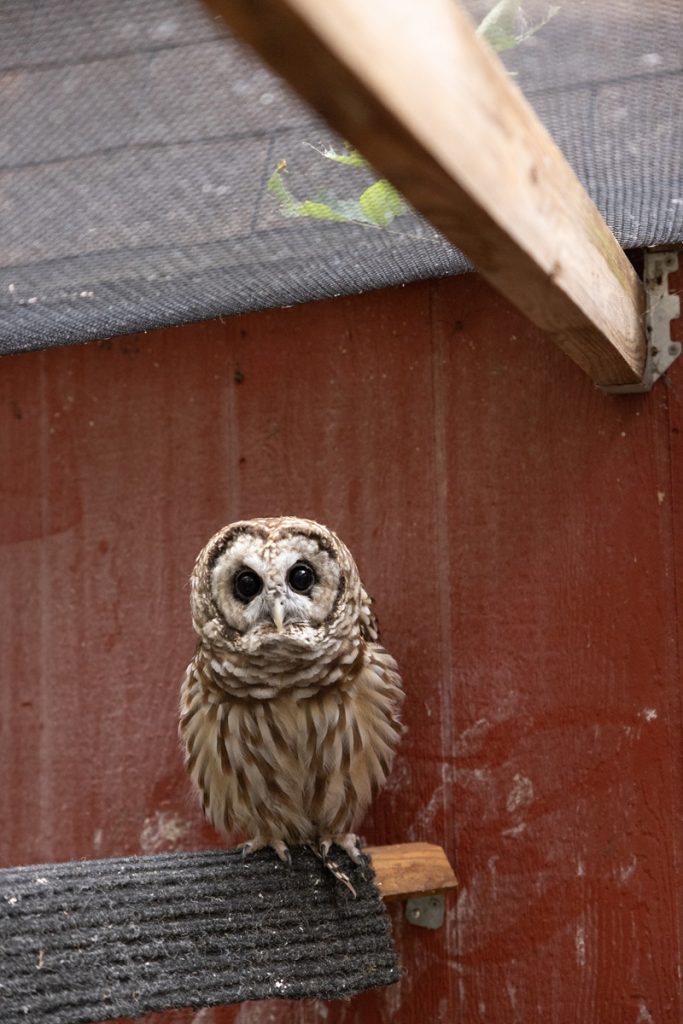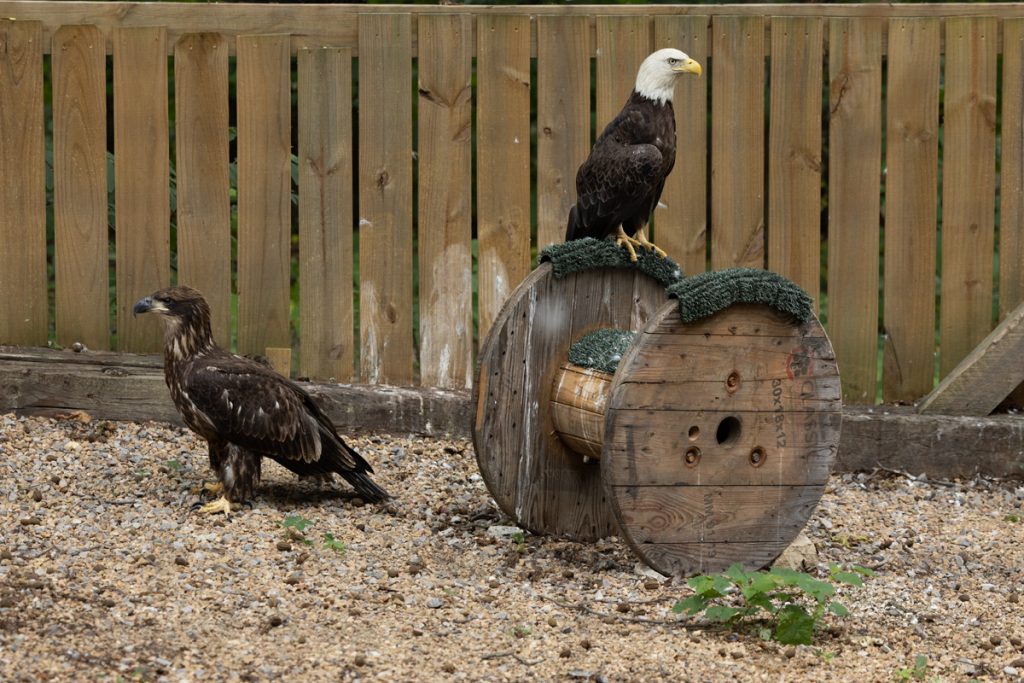Owl Ridge Raptor Center nurtures injured, displaced birds and returns them to the wild
Beak was a tiny owlet, homeless and on the ground when a dog sniffed him out. A great horned owl, he was passed along to wildlife rehabilitator Lynne McCoy and eventually to the Owl Ridge Raptor Center, operated by Lisa Thomison and her husband Chris out of their home in rural Washburn, Tennessee. Lisa raised him until he eventually passed “mouse school,” she says, proving he was able to hunt and feed himself. She released him, but six days later he was back, calling from a tree. When she held up an arm, Beak flew to her, landing gently. He had imprinted on the human that had saved his life.
Now Beak, who is five years old, is one of four ambassador owls that Lisa takes to educational programs she does in classrooms and libraries, state parks and 4H centers. There she shares information about the birds she admires and works to heal, nurture, and return to their native habitats.

But Beak also has serious work to do for his own species. Every spring when other great horned owlets find their way to Lisa’s care, Beak steps up as a foster parent, comforting them with his presence and teaching them important owl skills like hunting. Currently he’s fostering Cobweb, a female who will be released this fall.
Beak and Cobweb are two of about 30 owls, hawks, kestrels, and other birds of prey currently at Owl Ridge that have been injured or displaced, usually too young to survive on their own. An adult bald eagle is also among the residents, one that will never fly again thanks to the careless, illegal poacher who wounded him with a .22. He is one of four eagles Lisa knows of that had been shot in Tennessee in the previous six months.

“He couldn’t fly anymore, but I guess he was finding food on the ground, mostly carrion,” she says. Once he was trapped and delivered to Owl Ridge, he was so hungry that he would let Lisa approach with food. “When a wild animal will allow you to approach, they’re starving to death.”
Fed him she has, purchasing the large, smelly fish — carp and trout — that his diet requires, and the eagle’s health has been restored, even if his ability to fly is gone forever. In July, the Thomisons delivered him to a refuge at Reelfoot Lake State Park in west Tennessee. There at least he will be among his kind.
The Owl Ridge Raptor Center, a 501(c)3 nonprofit, grew out of the love for birds of prey that Lisa learned as a volunteer at the now-closed Clinch River Raptor Center in Claxton.
“I liked owls the most, they’re very mysterious and secretive, and I like the idea of them flying silently at night. They’re monogamous and mate for life, and they will defend their babies with their lives. Most mammals don’t do that,” she says, then adds, “I admire their tenacity.
“Kathy Strunk and Katie Cottrell (who ran the center) were my mentors. When they retired six year ago, I applied for my state permit from TWRA and got approved and then applied for my federal permit from US Fish and Wildlife.” Qualifications for approval are rigorous and include up to 200 hours of rehabilitation experience. Lisa also has a work background in biology and lab work.
She was approved again, and then had to construct the enclosures needed to house the birds moving over from Clinch River. For this, she relied on the help of Chris, a steelworker who commutes to Knoxville and who spends his spare time helping her with the birds.

“When she told me she would like to take up the torch (when Clinch River closed), I had no idea what that entailed,” he admits. But he agreed. Since then, he’s built 13 enclosures for the birds. Footed the bill for countless mice and rats and fish and quail they serve their feathered guests, a bill that runs about $300 a week during the busy times of the year. Helped pay the bills that mount even though their veterinarian, Andrew Skelly at Emory Animal Hospital in Powell, cuts them a break. Driven hours to programs or to collect injured birds. Even created their website, owlridge.org.
Lisa quit working elsewhere as the work at the raptor center grew. Last year, she estimates, they cared for about 150 birds of prey. For most, that might just mean feeding them. But for others, it also means medicating them. Birds that have been hit with lead shot, for instance, can develop lead poisoning. Treating them involves twice daily injections in the breast muscle for multiple weeks, a process neither bird nor human enjoys.
She works closely with TWRA and the American Eagle Foundation at Dollywood, as well as UT’s veterinarians, who do a lot of surgeries on injured birds. “They can put titanium plates in wings; it’s amazing,” she says. Though there’s another raptor center in Chattanooga and one in Johnson City, she believes hers is the only one with a 100-foot-long, L-shaped flight cage required to rehab eagles, built with volunteer help and donations and dedicated to the memory of Lynne McCoy.
When she has very young birds, Lisa often rises every three hours to feed them. She makes toys for them to shred or pounce on. She changes the water daily in the plastic pools in each enclosure. Handles the birds she takes out in public to keep them accustomed to human contact. Applies for grants to offset some of their expenses. Attends fundraisers with her ambassadors. Teaches kids all about the wild birds in her care.

In all, she does more than 20 educational programs a year and passes out plans for making nesting boxes. She also passes along advice intended to protect the birds she loves: Don’t trim or cut down trees in the summer, when they’re likeliest to contain nests. Don’t use poison to kill rodents because the birds that eat them will die too. Don’t throw food out your car window because it will attract rodents which attract raptors. And then cars hit them.
As we chatted over the course of an afternoon, Lisa learned of other birds in trouble. A young osprey had fallen out of its nest. Another bird was found injured and was on its way to UT Vet School. She prepared to take on more charges, helping to get them to adulthood and independence.
“I feel very lucky, very blessed to be able to do it.”
To learn more about the Owl Ridge Raptor Center

Comments are closed.